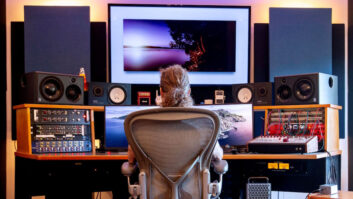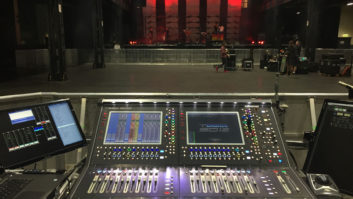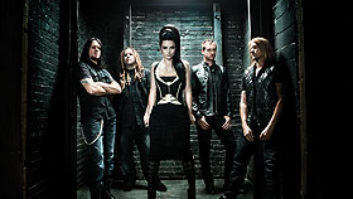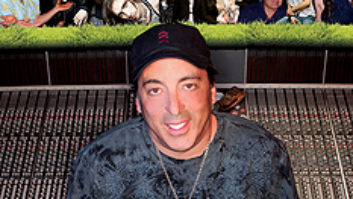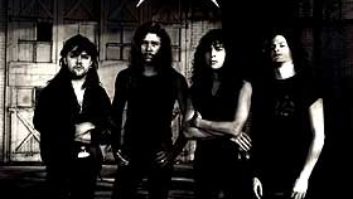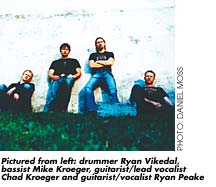
Sometimes, things just don’t go the way you plan them, and that canbe a good thing. When the Canadian hard-rock quartet Nickelback set outto create The Long Road, their follow-up to thequintuple-Platinum release Silver Side Up, they planned to bringin producers to work on the key singles. But instead, theirself-admitted procrastination and their label’s enthusiastic responseto their demos encouraged them to produce themselves for the firsttime. While recording commenced at Greenhouse Studios in Vancouver,frontman/lyricist Chad Kroeger, tired of the hour-long commute andwanting his own personal recording facility, bought all the gear in theA room and moved the production into his renovated barn.
“He got a design for the studio, called up a contractor andgave them 30 days to do it,” reveals engineer and co-producerJoey Moi. “The guys worked around-the-clock; people were pullingfavors left and right to make sure that it happened.”
The band kept “before and after” pictures of the barnupstairs, and they chronicled a dramatic transformation. The upstairsmixing room — complete with a vocal booth and a view of thesprawling acres behind the studio — was once the hayloft, whilethe downstairs rehearsal and recording facility originally comprisedhorse stalls.
A massive SSL console now inhabits the mixing room, but there isstill plenty of space for other gear and even a sofa. A neatly groomed,longhaired cat roams the premises, and for some odd reason, the cat cantolerate sitting between the monitors while they are blasting outintense hard rock. The adjacent room has been converted into a loungewith a full kitchen, a well-stocked refrigerator and a couch facing abig-screen TV. One might wonder how Kroeger’s neighbors have toleratedthe high volume levels, but considering that the renovated structure islocated on an isolated farmland in rural British Columbia, thereprobably aren’t many within hearing distance.
Nickelback spent the first two-and-a-half months recording TheLong Road at the Greenhouse. After a week break during the facilityconversion, the last few weeks were spent at Kroeger’s rural MountainView Studios. The construction took just 35 days, after which, someonefrom Greenhouse transplanted the gear into Mountain View.
The transition did not seem to hurt production. The finished versionof The Long Road finds Nickelback getting heavier, as evidencedby the aggressive track “Flat on the Floor” and theultrahard “Because of You,” a stomping rocker in the veinof Metallica. Like its predecessor, this album has its reflectivemoments, such as the acoustic guitar-laced single“Someday,” a tune that Kroeger calls “the anthem forlost promises.”
Nickelback’s music is direct and immediate: There are no extendedpreludes or codas to be found in their repertoire. They eschew lengthysolos or overt displays of virtuosity, preferring heavy, detunedguitars for power. Still, the group does put a lot of time into makingtheir music.
“The one thing we really got to do with this album that wedidn’t do with any other album — because we had time to dowhatever we wanted — was [to incorporate] layers andtextures,” says Kroeger, as we sit on the patio outside thestudio’s second-floor lounge on a warm, late-summer day. “Lots oflayers and textures, and recording tons and tons of stuff. We wouldrecord everything and listen to it all. There’s a mandolin on‘Someday,’ but you’ll never hear it. But it’s sittingthere. I love it when you can feel something, and you’re not sure whatit is you’re feeling but you can’t hear it. You can’t pick it up andknow exactly what it is.”
The singer says that “Someday” is the song the bandfocused on the most. It contains over 100 tracks of audio and featuresa dry acoustic guitar cutting through the heavy mix. A Gibson Jumboacoustic was recorded without amplification through both a Coles ribbonmic and a Neumann M147. And it doesn’t get buried. “You have tobe very aware of what the song requires and what it calls for,”expounds Kroeger. “If you just do everything balls-out, you’renot going to have the dynamics that you’re looking for.”

For this album, Nickelback recorded live to Pro Tools in the studio.“We set it up so they had a full P.A.,” says Moi (whoselast name rhymes with his first). “We made it like they wereonstage: They all had monitors and good headphone mixes. They wouldjust go in there and jam, and I would sit in here and have tape rolling[figuratively] the whole time that they were rehearsing and coming upwith ideas. That’s how we would start: Get a good performance of thesong that way, and then if the guys play the song well enough —there’s a good tempo and a good vibe — we’d start overdubbingdrums on top of that.”
Naturally, bleed-through becomes an issue when recording drums overpre-existing live tracks. “When the guys play downstairs, it’sall bleeding and really loud,” confirms Moi. “But when werecord it up here, we use a program called Amp Farm from Line 6. Wejust take a split off of their guitar amps so we can have everythingmodeled as though they’re playing live, but we just sneak an extracable in there that comes up to the computer. We have the amp-simulatorprogram and record a direct, clean guitar tone — the same withthe bass — with no leakage, DI’d into the mixing board and theninto the computer, which then processes it. You create the amp sound inthe computer and it records it. You can simulate any amp you want [withAmp Farm]. It sounds good. When the drummer re-tracks the drums, heplays to the clean guitar tracks, which don’t have any leakage in them,and a click.”
One song that did not include the entire band playing together istheir testosterone-fueled interpretation of the Elton John/BernieTaupin hit, “Saturday Night’s Alright for Fighting,” whichincludes vocal contributions from Kid Rock and guitar work from Panteraguitarist “Dimebag” Darrell. Due to time constraints andschedule conflicts, Nickelback sent music files to each of thoseguests, and they added their parts in studios in Michigan and Texas,respectively.
While that song required a bit of preparation and arrangement,particularly as it was a cover, the originals on the album often flowedfrom studio jamming. Some songs developed from rehearsals or demos, butthis was nothing new for the band. The hit “How You RemindMe,” which helped propel Silver Side Up to multi-Platinumstatus, was practically the original demo, according to guitarist RyanPeake. “We just put a few more things on top of it, but most oftracks were from the demo on that one,” he says.
The band now has a nice studio to play in. Kroeger also owns afamous SSL console: Aerosmith’s Pump, Mötley Crüe’sDr. Feelgood, The Cult’s Sonic Temple, Bon Jovi’sSlippery When Wet and parts of Metallica’s black album were allrecorded on it. The board originally resided at Bruce Fairbairn and BobRock’s downtown Vancouver studio, Little Mountain, which was relocatedto suburban Burnaby and renamed Greenhouse Studios.
Four songs from the new album were recorded at Mountain View:“Flat on the Floor,” “Believe It or Not,”“Should Have Listened” and “I Need You.” Whilethe gear was essentially the same as at Greenhouse, it took the studiocrew a couple of songs to adjust to the new environment. “It wasdifferent, but we got used to it really quick,” says Moi.“At the same time, we were putting up baffles and treating theroom and making it better. The process went relatively fast for gettingthe studio to an acceptable level. [Moving the gear] took the leastamount of time. It took a day, and the room was pretty much ready togo. At the same time, the guys were working on new tunes.”
The engineer miked the guitarists’ amps with SM57s. The ampsincluded a Mesa Boogie Triple Rectifier with a 4/12 cabinet, PeaveyTriple X amp with a 4/12 Peavey cabinet, Vox AC30 and Fender Twin. Moiused one mic per cabinet. “We had one performance on eitherside,” he says. “We would record one mono track and thenrecord another mono track. It makes it really thick. We’d blend all ofthe amps down into one track and record two tracks: a left and a right.Then, when the chorus comes, you get them to do it four times and havetwo guitars on each side.”
Recording Mike Kroeger’s Spectre bass (with CompTortioncompression/distortion pedal) was similar to that of the guitars. SM57swere used to mike a Peavey GPS Power Amp, Peavey Pro Bass 500 amp andPeavey Triple X combo. “We would record a direct signal, straightout of the bass, and then we would combine a bunch of amplifiers downto one track, as well,” Moi explains.
As for the drums, Ryan “Nik” Vikedal has got “ahuge kit,” Moi says. “Normally, we don’t have to usethis much. A modest drum kit is a kick, snare, two toms, a couple ofcymbals and a hi-hat.” But Nickelback’s skinbeater has twosnares, four toms, two hi-hats and a surplus of cymbals. To recordVikedal, Moi says they placed one mic inside and outside of the kick (acombination of a D-112 inside and Neumann M147 and NS-10 outside), plusone on top and below the snare (an SM57 and a RØDE NT5). They usedSM7s on the hi-hats, two KM184s on the Zildjian cymbals, a RØDENT5 on the ride cymbal, two RØDE NTKs as overheads and 421s aboveeach tom with SM57s below them. Room mics included two RØDENT1000s and a Coles ribbon mic.
Vocals were recorded in the upstairs vocal booth with a simple setupof a RØDE NTK tube mic running through a Neve 1084 preamp, UREI1176 compressor and Avalon 737 SP mic processor. “If I’mscreaming, we need to be able to have a diaphragm that’s going to beable to handle the screaming and is not going to gut out some of thestuff,” explains frontman Kroeger.
“He’s got one of the loudest voices,” declares Moi [anotion that Peake quickly seconds]. “He’s like a weapon.He can destroy microphones quickly. We used the same one the wholetime. He would turn it away on certain syllables, like ‘p’sand ‘f’s.” Kroeger evidently became very adept at hisspecial technique.
Vocals were recorded mono; for choruses, they were doubled.“It all depends on the song,” says Moi. “Some songsneed all those layers.” Some of the mono harmonies were latertreated with stereo effects (such as chorus or reverb) by Randy Staubduring the mixing process at The Warehouse in downtown Vancouver on anSSL 4072 console. George Marino later mastered the album at SterlingSound.
While The Long Road ultimately features a few songs withdozens of tracks layered on top of each other, the album does not feellike a bloated production. “I’m glad that it sounds like that,because there are a million things going on,” saysKroeger. “There are a lot of things you cannot hear that you canfeel. It adds to the song. We made sure that everything we lefton tape was only adding to the song and wasn’t just something extrathat was sitting there.”
Ultimately, Nickelback’s philosophy is best summed up by these wordsfrom Kroeger: “Every cake we bake has the same ingredients, it’sjust how much stuff we decide to throw into the icing.”
